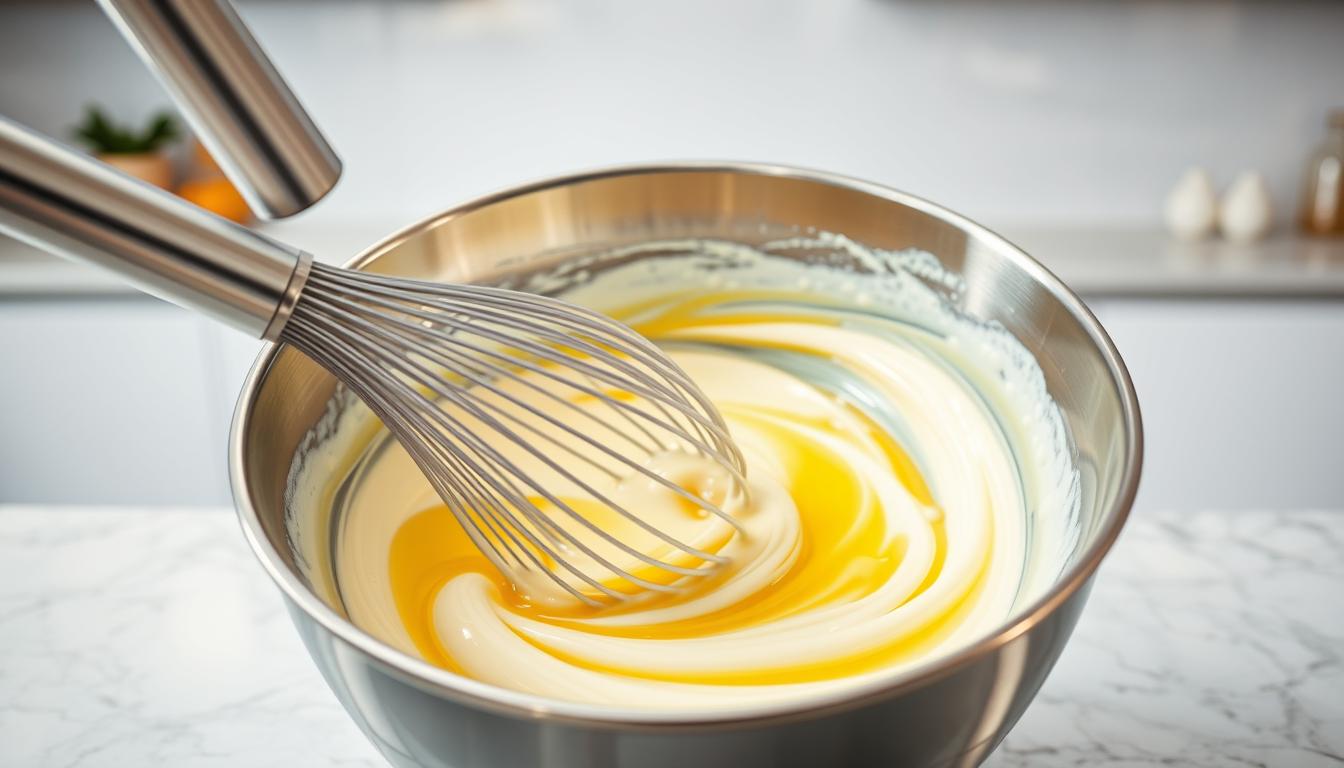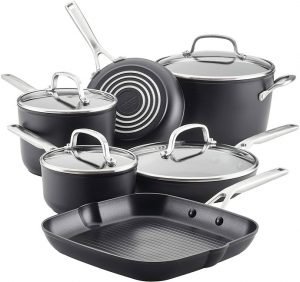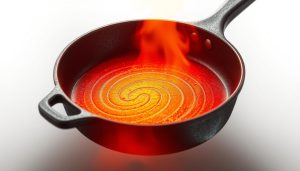Did you know that over 90% of home cooks experience emulsion failures when making mayonnaise? Even culinary legend Julia Child battled this issue, noting how cold weather caused her mayo to separate until she applied heat to stabilize it. This struggle reveals a hidden truth: your kitchen is a laboratory where oil and water can coexist—if you understand the rules.
Emulsions power everything from creamy dressings to glossy sauces. They occur when two unmixable liquids—like oil and vinegar—form a stable bond through careful technique. Temperature, ingredient ratios, and even air humidity play roles in their success or failure. For example, Child’s hot-water trick works because warmth helps egg proteins bind oil droplets more effectively.
Mastering these mixtures transforms cooking from guesswork to precision. Whether whisking a vinaigrette or blending hollandaise, you’re manipulating molecules. Tiny fat particles get surrounded by emulsifiers like lecithin in eggs, creating textures that elevate dishes. This principle extends beyond food—emulsions shape products like lotions and paints—but your kitchen offers the tastiest experiments.
Want to dive deeper? Explore how scientific principles shape everyday cooking, unlocking consistent results in your recipes.
Key Takeaways
- Emulsions blend oil and water using scientific methods, crucial for sauces and dressings
- Temperature and ingredient quality directly impact emulsion stability
- Egg proteins act as natural emulsifiers by coating oil molecules
- Famous chefs use controlled techniques to prevent separation
- Emulsion science applies to cosmetics and industrial products
- Precision beats guesswork in achieving perfect textures
Exploring the Fundamentals of Emulsions
Why do oil and vinegar fight until you add an emulsifier? Their molecules repel each other like magnets with matching poles. Water’s polar structure clashes with oil’s nonpolar properties, creating an energy barrier that resists mixing. Overcoming this requires force—like whisking—to break liquids into microdroplets.

Understanding What Emulsions Are
An emulsion forces temporary peace between oil and water. Tiny fat droplets get trapped in water (or vice versa), scattering light to create that creamy white hue. Without stabilizers, these mixtures separate quickly—like a broken vinaigrette.
Surfactants act as referees. Egg yolks contain lecithin, whose molecules have oil-loving and water-loving ends. They coat fat droplets, preventing them from reuniting. Mustard’s sticky mucilage works similarly, making it essential in dressings.
Key Ingredients and Roles of Egg Yolk, Mustard, and Vinegar
Egg yolks provide lecithin for long-term stability. Mustard adds mucilage carbohydrates that bind oil and water. Vinegar’s acidity tightens protein bonds in emulsifiers, strengthening the mixture.
Timing matters. Add oil too fast, and the process fails. Drizzle it slowly while whisking to create enough surface tension for droplets to form. This technique builds structure—whether making mayo or a glossy sauce.
The Science of Emulsions: From Mayo to Vinaigrettes
What keeps oil and water from separating in your favorite dressing? The answer lies in molecular matchmakers called emulsifiers. These ingredients act like diplomats, negotiating peace between clashing liquids through precise chemical interactions.

Emulsifying Agents and Their Molecular Interactions
Egg yolks contain phospholipids—molecules with oil-loving tails and water-friendly heads. They wrap around fat droplets like protective shields. Mustard’s sticky mucilage performs a similar role, trapping oils while adding tangy flavor.
Acidic ingredients like vinegar tighten protein bonds in emulsifiers. This creates a stronger network to hold mixtures together. Always hydrate eggs with water or lemon juice first—it unfolds proteins for better binding power.
Temperature, Mixing Methods, and the Role of Surfactants
Surfactants (short for “surface-active agents”) reduce tension where oil and water meet. Cold eggs struggle to emulsify—warm them slightly to boost molecular activity. Pour oils slowly while whisking vigorously. This creates tiny droplets that stay suspended.
| Natural Emulsifier | Commercial Alternative | Key Function |
|---|---|---|
| Egg yolk phospholipids | Vegetable gum (e.g., xanthan) | Bind oil/water layers |
| Mustard mucilage | Polysorbate 60 | Reduce surface tension |
| Vinegar + proteins | Lecithin isolates | Stabilize droplet formation |
Store-bought dressings use plant-based gums for shelf stability. But homemade versions let you control textures—add extra mustard for thicker emulsions or citrus juice for lighter ones. Remember: successful emulsifying depends on balancing molecular forces, not just brute mixing.
Troubleshooting and Enhancing Your Emulsions
Even experienced cooks face emulsion breakdowns. When sauces split or dressings separate, it often stems from overlooked scientific principles. Mastering rescue techniques transforms kitchen disasters into learning opportunities.
Common Challenges: Separation and Curdling Explained
Temperature shifts wreak havoc on delicate mixtures. Cold environments slow molecular bonding—Julia Child’s famous mayo struggles disappeared when she warmed ingredients over hot water. Conversely, excessive heat melts butter in hollandaise, causing irreversible separation.
Rushing the adding oil process guarantees failure. Pouring too fast overwhelms emulsifiers’ capacity to coat fat droplets. Watch for sudden thinning or greasy textures—these signal imminent breakdown.
Practical Tips to Prevent and Fix Emulsion Failures
Start with room-temperature egg yolks and chilled oil. Whisk lemon juice or vinegar into yolks first—the acid unfolds proteins for better binding. Add oil drop-by-drop until the base thickens, then stream slowly while maintaining vigorous mixing.
Broken mayonnaise? Whisk 1 teaspoon of failed mixture into a fresh yolk, then gradually incorporate the rest. For hollandaise, create a new base with warm butter and slowly blend in the separated sauce.
| Problem | Quick Fix | Prevention |
|---|---|---|
| Grainy texture | Add warm water (1 tsp) | Control mixing speed |
| Oil pooling | Use immersion blender | Verify ingredient temps |
| Curdled appearance | Strain through sieve | Monitor heat sources |
Successful recipes balance science with intuition. Record environmental conditions and adjustment ratios—this creates reliable home cooking systems. Remember: emulsion mastery comes through controlled experimentation, not perfection.
Conclusion
Mastering emulsions unlocks culinary precision that transcends recipes. When oil and water cooperate through proper technique, they create velvety sauces and balanced dressings that elevate meals. This knowledge extends beyond your kitchen—these mixtures shape cosmetics, paints, and even vaccines.
Simple ingredients like egg yolks and vinegar become powerful tools when you control their interactions. Understanding temperature’s role and emulsifier functions turns trial-and-error into reliable results. Broken mixtures? Now you fix them with science, not guesswork.
Every successful vinaigrette or hollandaise proves a universal truth: opposing elements can unite beautifully. Apply these principles to craft dishes with professional textures while appreciating their broader scientific significance. Your cooking becomes both experiment and art—where molecules and creativity collide.
Keep experimenting. Each emulsified sauce reinforces how microscopic interactions shape flavors on your plate. That’s the delicious paradox of kitchen science: complexity mastered through fundamental understanding.



